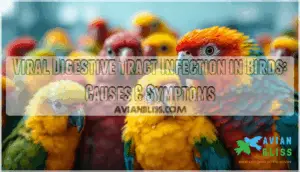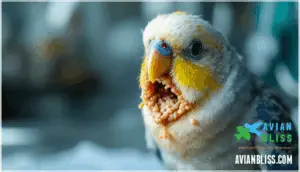This site is supported by our readers. We may earn a commission, at no cost to you, if you purchase through links.

Unlike bacterial infections that respond to antibiotics, these viral assaults demand a different approach entirely. Recognizing the specific signs, understanding which viruses pose the greatest threat, and knowing how these pathogens spread through your flock can mean the difference between a manageable health challenge and devastating losses.
Table Of Contents
- Key Takeaways
- What Are Viral Digestive Tract Infections in Birds?
- Major Viruses Affecting Avian Digestive Systems
- Transmission Routes of Avian Viral Infections
- Clinical Signs of Viral Digestive Infections
- Diagnosing Viral Digestive Infections in Birds
- Treatment and Supportive Care Options
- Prevention and Control in Aviaries and Flocks
- Frequently Asked Questions (FAQs)
- What is a viral disease that affects the digestive tract of a bird?
- How to treat viral infection in birds?
- How contagious is PDD in birds?
- What are the symptoms of the Borna virus in birds?
- What are the dietary recommendations during viral infection?
- How do viral infections differ from bacterial ones?
- What factors increase a birds susceptibility to viruses?
- Can environmental changes trigger viral infections in birds?
- Are certain bird species more prone to viral infections?
- What are long-term complications of viral infections?
- Conclusion
Key Takeaways
- Viral digestive infections in birds—caused by coronaviruses, reoviruses, herpesviruses, and papillomaviruses—don’t respond to antibiotics and often appear as mixed infections in 79% of flocks, requiring laboratory testing to distinguish them from bacterial, fungal, or parasitic causes.
- Transmission occurs primarily through fecal-oral routes in contaminated food, water, and shared surfaces, with some viruses like Pacheco’s disease spreading so rapidly that sudden death may occur before digestive symptoms like diarrhea or regurgitation even appear.
- Treatment focuses entirely on supportive care—aggressive hydration, nutritional support through syringe feeding, and managing secondary bacterial or fungal infections—since antiviral medications remain limited in avian medicine and most cases require the bird’s own immune system to fight back.
- Prevention strategies combining strict biosecurity (daily waste removal, dedicated clothing, foot baths), 30-45 day quarantine protocols for new birds, and targeted vaccination programs provide the most effective defense against outbreaks in aviaries and flocks.
What Are Viral Digestive Tract Infections in Birds?
Viral digestive tract infections in birds occur when specific viruses invade and replicate within the gastrointestinal system, disrupting normal digestive function and causing a range of clinical symptoms. Understanding these infections requires knowledge of the causative agents, how they differ from bacterial or fungal infections, and what makes them particularly challenging to treat.
Let’s examine the fundamental aspects of viral digestive infections, starting with their definition and the most common viral agents you’ll encounter.
Definition and Overview
Viral digestive tract infections in birds occur when specific viruses invade and replicate within the cells lining the gastrointestinal system, disrupting normal digestive function and often causing life-threatening illness. Unlike bacterial or fungal digestive infections, these viral pathogens target specific cell types in your bird’s gut, reproducing inside them and destroying healthy tissue.
Viral digestive infections in birds strike when pathogens hijack gut cells to replicate, destroying tissue and causing life-threatening illness untreatable by antibiotics
You’ll find that viral infections in birds spread rapidly through flocks, don’t respond to antibiotics, and can affect everything from the mouth to the cloaca, making early recognition critical.
Common Viral Agents
When you’re dealing with digestive tract infections in birds, you need to understand the viral diversity at play. Avian influenza virus stands out—with over 100 wild bird species documented as carriers, this respiratory and gastrointestinal pathogen spreads through feces, respiratory secretions, and saliva. Genetic reassortment allows these viruses to adapt rapidly. Cross-species transmission makes things worse; H5N1 has even jumped to dairy cattle and humans. Molecular detection reveals that mixed infections occur in 79% of flocks, complicating diagnosis and treatment. The H5N1 influenza outbreak has been ongoing in the US since early 2022.
The most common viral agents causing digestive issues in your birds include:
- Avian coronavirus – detected in 56.4% of commercial flocks and 69% of flocks with diarrhea
- Avian reovirus – ubiquitous in poultry, causing malabsorption syndrome and growth retardation
- Rotavirus and astrovirus – found in 9.9% and 29.7% of tested flocks respectively
- Avian papillomavirus – causes thickened tissue growths resembling pink cauliflower throughout the digestive tract
These viruses don’t work alone—mixed infections are the rule, not the exception, making viral infections in birds particularly challenging to manage.
Differences From Other Digestive Infections
You can’t rely on symptoms alone to tell viral infections apart from bacterial, fungal, or parasitic ones—diarrhea looks like diarrhea whether it’s from rotavirus or Giardia. That’s where disease diagnosis becomes critical.
Bacterial overgrowth improves with antibiotics, fungal infections need antifungals, and parasitic infestations require specific dewormers. Viral infections, however, won’t improve with any of these treatments.
Toxin ingestion and nutritional deficiencies can mimic digestive system infections entirely, making laboratory testing essential for accurate diagnosis of avian diseases.
Major Viruses Affecting Avian Digestive Systems
Several viral pathogens can wreak havoc on your bird’s digestive system, each with distinct characteristics and clinical implications. Understanding which viruses pose the greatest threat helps you recognize symptoms early and seek appropriate veterinary care.
Let’s examine the four major viral families that most commonly affect avian digestive health.
Avian Herpesvirus (Pacheco’s Disease)
Pacheco’s disease, caused by Psittacine herpesvirus, strikes New World species like Amazon parrots, macaws, and conures with devastating speed. You’ll see sudden death in previously healthy birds, often before digestive signs like bile-stained droppings or regurgitation appear.
Herpesvirus transmission occurs through fecal-oral routes and contaminated surfaces, making species susceptibility a critical concern in mixed aviaries. A study found that herpesviruses infect passerines, indicating a broader range of susceptible avian species.
Disease management focuses on strict biosecurity and quarantine, while prevention strategies include testing new birds before introduction to your flock.
Avian Papillomavirus
Papillomatosis develops when viruses trigger cauliflower-like growths throughout your bird’s gastrointestinal tract, from mouth to cloaca. Duck Papillomavirus showed striking prevalence rates in wild waterfowl studies, while Kittiwake Colonies recorded infection rates exceeding 81% in some populations.
Key characteristics of avian papillomavirus include:
- Lesion Morphology: Thickened pink tissue growths resembling cauliflower in the digestive system
- Species Variation: Gull Positivity reached 17%, with black ducks showing 29.4% infection rates
- Clinical Impact: Obstructs normal digestion when papillomas block the esophagus or intestines
Rotavirus and Coronavirus
Rotavirus gastroenteritis and coronavirus shedding pose distinct threats to your flock’s digestive system. Infectious bronchitis virus (IBV) persistence dominates commercial poultry outbreaks globally, with coronaviruses detected in 26.5% of domestic pigeons—noticeably higher in young birds at 34%. Viral enteritis from these avian viruses spreads through fecal contamination, persisting for weeks.
| Virus Type | Key Digestive Impact |
|---|---|
| Rotaviruses | Gastrointestinal tract infections in poultry |
| Coronaviruses (IBV) | Fecal excretion for several weeks post-infection |
| Turkey Enteritis | Transmissible intestinal disease in turkeys |
| Field Strains | Prolonged cecal tonsil shedding despite vaccination |
Reovirus and Adenovirus
Adenovirus routinely triggers devastating gizzard lesions and pancreatitis in your broiler chickens, with experimental studies confirming necrotizing damage throughout the gastrointestinal tract.
Southeastern U.S. labs frequently identify these avian viral diseases alongside proventriculitis and bursa atrophy. Reovirus co-infections worsen watery feces and impaired growth.
Both viruses replicate in the proventriculus and duodenum, causing viral diarrhea in poultry that severely impacts feed conversion.
Transmission Routes of Avian Viral Infections
Understanding how these viruses spread is essential for protecting your birds from infection. Viral digestive infections don’t appear out of nowhere—they follow predictable pathways from infected to healthy birds.
Let’s look at the four main routes these pathogens take to infiltrate your flock.
Fecal-Oral Transmission
The fecal-oral route stands as the most common pathway for viral digestive infections to spread through bird populations, where droppings from infected birds contaminate the environment and are inadvertently ingested by healthy birds.
This transmission pattern accelerates dramatically in overcrowded conditions, where environmental contamination from feces becomes unavoidable. Birds encounter viral particles while foraging, preening, or drinking from shared sources.
Poor hygiene practices create risk factors that fuel disease outbreaks, making strict control measures essential for preventing fecal contamination and interrupting viral transmission cycles.
Contaminated Food and Water
When food dishes and water containers become contaminated with viral particles, they transform into concentrated sources of infection that can sicken an entire flock within hours. Waterborne pathogens and feed contamination often result from fecal contamination near feeding stations, allowing viruses to enter the gastrointestinal tract directly.
Proper storage practices and source tracking help identify contamination points before disease transmission escalates, protecting your birds from exposure to these dangerous pathogens.
Direct Bird-to-Bird Contact
Physical interactions between infected and healthy birds create direct pathways for viral particles to spread through your flock, turning routine social behaviors into transmission opportunities. Social contact during preening behavior and shared perches promotes viral shedding, while feather dust carries pathogens through the air. Nesting proximity increases disease transmission risks.
Watch for these contagious disease pathways:
- Mutual grooming sessions where saliva transfers viral diseases in birds between companions
- Aggressive encounters that create open wounds, allowing direct viral entry
- Crowded housing conditions where quarantine procedures become critical to prevent outbreak escalation
Vertical (Egg) Transmission
Some viruses don’t wait for social contact—they hitch a ride directly into their offspring through infected eggs. Eggshell contamination and contagious diseases cause congenital infections that devastate hatching rates before chicks even emerge.
Breeder screening catches viral shedding early, while maternal antibodies sometimes protect offspring. However, vertical disease transmission of viral diseases in birds and avian diseases means infected parents can doom entire clutches, making breeding stock health your first line of defense.
Clinical Signs of Viral Digestive Infections
When a viral infection establishes itself in your bird’s digestive system, you’ll notice signs that something’s gone wrong. These symptoms can range from obvious changes in droppings to subtle shifts in behavior and appetite. Recognizing these clinical signs early gives you the best chance to get your bird the veterinary care it needs.
Diarrhea and Dehydration
Diarrhea hits fast in viral infections, turning droppings watery and often signaling your bird’s digestive system is under serious attack. Dehydration follows quickly, especially in smaller species, as fluid loss from diarrhea strips away essential electrolytes. You’ll notice sunken eyes, lethargy, and decreased skin elasticity—signs that demand immediate fluid therapy and nutritional support to prevent fatal gastrointestinal issues.
- Watch for droppings that lack any solid component, appearing purely liquid
- Check your bird’s keel bone—it becomes more prominent as dehydration worsens
- Monitor water intake closely, as sick birds often stop drinking despite severe fluid loss
Regurgitation and Crop Stasis
Regurgitation becomes a red flag when food backs up from the crop, leaving partially digested material stuck in that pouch-like storage organ and creating a breeding ground for viral replication. Viruses targeting avian digestive systems disrupt normal crop motility, amplifying regurgitation causes and compromising nutritional impact as your bird can’t absorb essential nutrients from stalled food.
Crop emptying slows or stops entirely, causing stasis severity that escalates aspiration risks if material enters the respiratory tract.
Weight Loss and Anorexia
Your bird’s appetite vanishes as viral infection takes root, triggering rapid weight loss that strips away muscle and fat reserves faster than you’d expect. Appetite suppression pairs with malabsorption issues as damaged digestive tissues can’t extract nutrients, creating a calorie deficiency that accelerates muscle wasting.
Metabolic changes from viral diseases compound these digestive problems, turning mild anorexia into a dangerous downward spiral.
Lethargy and Poor Growth
Infected birds lose their spark—listlessness replaces normal activity while growth in young birds stalls or stops entirely. Feather development suffers as protein reserves dwindle, and immune suppression from viral diseases makes lethargy one of the most noticeable symptoms of avian diseases you’ll observe.
Energy depletion from digestive problems leaves little fuel for development, causing growth stunting and muscle wasting.
Diagnosing Viral Digestive Infections in Birds
When your bird shows signs of digestive distress, pinpointing the exact viral culprit requires a methodical diagnostic approach.
Your veterinarian will use several techniques to confirm whether a virus is behind your bird’s symptoms and, if so, which one. Here’s what you can expect during the diagnostic process.
Clinical Examination and History
When you suspect a viral digestive infection, the first step isn’t reaching for diagnostic tools—it’s taking a thorough history and conducting a hands-on clinical examination that can reveal patterns other tests might miss. Your clinical approach should include:
- Initial Observations: Note posture, feather condition, and respiratory effort before interacting
- Owner Interview: Ask about diet changes, recent bird additions, and onset of disease symptoms
- Palpation Techniques: Feel the crop for stasis or thickness and assess body condition
- Hydration Assessment: Check skin turgor and mucous membrane moisture to gauge dehydration
- Fecal Analysis: Observe color, consistency, and volume of droppings for clinical signs
This systematic examination establishes baseline clinical presentation of diseases, guiding when veterinary attention requires sophisticated diagnostics.
Virus Isolation and Serology
Beyond clinical examination, virus isolation and serological assays provide definitive identification of viruses causing digestive disease. You’ll collect cloacal swabs, fecal samples, or tissue biopsies for viral culture, allowing virus replication in laboratory conditions.
PCR diagnostics detect viral genetic material rapidly, while antibody detection through serological testing reveals antigenic characterization of viruses and immune response patterns.
These methods confirm viral diseases in birds and guide treatment decisions when clinical signs alone aren’t conclusive for avian disease diagnosis.
Histopathological Findings
Tissue analysis under the microscope reveals cellular damage patterns that pinpoint exactly which virus attacked your bird’s digestive system. You’ll see distinctive lesion morphology showing tissue damage in the intestines and stomach, helping veterinarians distinguish between various gastrointestinal diseases.
Key histopathological findings include:
- Cellular changes like nuclear inclusions or syncytia formation indicating viral presence
- Epithelial necrosis patterns varying by virus type affecting intestinal lining
- Inflammatory responses showing diagnostic significance for identifying specific avian viruses
Treatment and Supportive Care Options
Treating viral digestive infections in birds isn’t about curing the virus itself—most of the time, there’s no magic bullet for that. Instead, your focus shifts to keeping your bird stable, comfortable, and strong enough for its immune system to fight back.
The following approaches form the backbone of effective supportive care and help prevent complications that can turn a manageable infection into something far worse.
Supportive Fluid and Nutritional Therapy
Most birds with viral digestive infections won’t recover through medication alone—they need aggressive hydration and specific nutrition to survive the battle their bodies are waging.
Fluid administration corrects electrolyte balance and combats dehydration, while nutritional support through syringe feeding prevents malnutrition when appetite disappears.
Your avian medicine veterinarian will customize supportive care protocols, sometimes adding appetite stimulants to encourage voluntary eating during treatment.
Use of Antiviral Medications
Antiviral drugs remain limited in avian medicine, but specific medications show promise for certain viral digestive infections. Acyclovir efficacy against Pacheco’s disease herpesvirus has been documented at 80 mg/kg orally, achieving complete survival during treatment. Penciclovir therapy suppresses duck hepatitis B virus replication, though resistance development occurs after discontinuation.
Interferon benefits include improved survival rates in psittacine circovirus infections. Emerging antivirals like oseltamivir target avian influenza, offering additional treatment options for birds requiring supportive treatment beyond hydration alone.
Managing Secondary Infections
Viral infections compromise immune defenses, creating openings for bacterial and fungal pathogens to establish foothold infections in your bird’s already-stressed digestive system. Antimicrobials target secondary bacterial invaders, while antifungal medication manages fungal overgrowth from antibiotic overuse.
Supportive care restores probiotic balance and immune support, but hygiene importance can’t be overstated—clean environments prevent reinfection while medications work to stabilize your bird’s immune system.
Probiotics and Digestive Health
Once secondary infections are under control, rebuilding your bird’s gut microbiome with beneficial bacteria becomes the next critical step in recovery. Species-specific probiotics support gastrointestinal health and immune function, but dosage guidelines vary widely across avian species.
You’ll need high-quality supplements formulated specifically for bird digestion, as mammalian probiotics don’t colonize avian intestinal tracts effectively. Proper supplement quality makes certain beneficial bacteria survive passage through your bird’s digestive system to restore normal flora.
Prevention and Control in Aviaries and Flocks
Preventing viral digestive infections in your aviary or flock isn’t just about reacting when birds get sick—it’s about building a defense system that keeps disease from ever taking root. You can’t eliminate every risk, but you can stack the odds in your favor with the right strategies.
Here’s what works to protect your birds before problems start.
Biosecurity and Sanitation Practices
Keeping viruses out of your aviary starts with a solid defense—think of biosecurity as your first line of protection against disease outbreaks. Strong cleanliness protocols and disinfection methods work hand-in-hand with proper waste management to stop pathogens before they spread. Here’s what effective aviary management looks like:
- Daily removal of droppings and contaminated bedding prevents fecal-oral transmission
- Weekly deep cleaning with avian-safe disinfectants eliminates viral particles on surfaces
- Foot baths and dedicated clothing for caretakers reduce cross-contamination between bird areas
Your quarantine procedures and hygiene training create layers of disease prevention that safeguard your flock’s health.
Vaccination Strategies
Pairing biosecurity with targeted vaccination strategies for birds strengthens your avian disease prevention arsenal. Prime-boost efficacy studies show that combining inactivated vaccines with adjuvants achieves 100% protection against lethal challenges, while VLP vaccines deliver enhanced cellular immunity.
Route optimization matters—subcutaneous administration consistently outperforms intranasal delivery in transmission reduction.
Be aware of adverse effects like injection site inflammation and rare neurological reactions when implementing viral disease control strategies in your flock.
Quarantine and Isolation Protocols
Implementing strict quarantine protocols acts as your first line of defense when introducing new birds or managing suspected infections in your flock. Isolate new arrivals for 30-45 days in a separate quarantine space with independent ventilation, feeding equipment, and caretaker protocols.
This isolation duration allows subclinical infections to manifest while preventing disease transmission. Enforce protocol rigorously—dedicated clothing, footwear, and handwashing reduce zoonotic risks and cross-contamination between quarantined and established birds.
Monitoring and Early Detection
Catching viral infections early—before clinical signs spiral out of control—demands vigilant daily observation and systematic flock monitoring practices.
Watch for Behavioral Changes like reduced activity or altered vocalization, and conduct Fecal Monitoring to detect abnormalities in consistency or color.
Regular Checkups, Weight Tracking, and Crop Palpation help you identify symptoms of bird illness before they progress, facilitating prompt veterinary attention when avian disease symptoms emerge.
Frequently Asked Questions (FAQs)
What is a viral disease that affects the digestive tract of a bird?
Pacheco’s disease, caused by Psittacine herpesvirus, targets the liver and digestive system in parrots, especially Amazons, macaws, and conures.
This infection demonstrates how viral pathogenesis disrupts normal digestion in avian species.
How to treat viral infection in birds?
Ironically, there’s no magic pill that erases viruses overnight—treatment hinges on supportive care and letting your bird’s immune system do the heavy lifting.
Your veterinarian may prescribe antiviral medications if available, though their efficacy varies.
How contagious is PDD in birds?
PDD transmission occurs primarily through viral shedding in feces, though the exact contagion rate remains uncertain. Avian bornavirus spreads via environmental contamination and direct contact.
Risk factors include stress and crowding. The incubation period extends months to years, complicating control measures for this challenging parrot health issue.
What are the symptoms of the Borna virus in birds?
Studies show avian bornavirus affects up to 30% of captive psittacines. Your bird may exhibit neurological symptoms like head tremors, incoordination, and seizures.
Behavioral changes include lethargy and decreased appetite, while some birds develop feather abnormalities, making diagnosis challenging despite clear clinical signs.
What are the dietary recommendations during viral infection?
During infection, you’ll need to focus on easily digestible foods and proper hydration. Offer bland diets like cooked rice or baby bird formula to reduce digestive stress, while fresh water remains available constantly to prevent dehydration and support recovery.
How do viral infections differ from bacterial ones?
Viruses differ fundamentally from bacterial infections in replication mechanisms and cellular impact. Viruses hijack your bird’s cells to reproduce, while bacteria multiply independently.
Treatment approaches vary greatly—antibiotics target bacterial infections but won’t affect viruses. Mutation rates in viruses complicate immune response development.
What factors increase a birds susceptibility to viruses?
Think of your bird’s defenses like a castle under siege—weakened walls invite trouble. Stress factors, nutritional deficiencies, and immunosuppression compromise the immune system, making pet birds vulnerable to viruses and infections.
Environmental hygiene and genetic predisposition also play significant roles in avian susceptibility.
Can environmental changes trigger viral infections in birds?
Environmental changes don’t directly trigger viral infections in birds, but they create stress factors that cause immune suppression. Climate change, habitat loss, and environmental instability weaken your bird’s immune response, making existing viruses more likely to cause disease and increasing viral shedding among infected avian populations.
Are certain bird species more prone to viral infections?
Yes, certain parrot species and pet birds show greater susceptibility to specific avian infections due to genetic factors and immune response variations. New World species like Amazon parrots, macaws, and conures are particularly vulnerable to Pacheco’s disease, while cockatiels often develop giardiasis.
What are long-term complications of viral infections?
Viral damage can lead to immune suppression, making birds vulnerable to secondary pet bird diseases. Organ damage and internal lesions may persist, while chronic shedding spreads infection.
Some viruses cause neurological effects or growth stunting in young birds.
Conclusion
You might think viral digestive tract infections always demand emergency veterinary visits, but early recognition often makes home supportive care sufficient for mild cases.
The key lies in distinguishing viral digestive tract infection in birds from bacterial or parasitic causes—a skill that starts with understanding transmission patterns, recognizing clinical signs like dehydration and crop stasis, and implementing strict biosecurity before illness spreads.
By combining diagnostic awareness with preventive measures like quarantine protocols and sanitation, you’ll transform from reactive caretaker to proactive guardian of your flock’s gastrointestinal health.
- https://scholar.google.com/scholar_lookup?title=Comparative%20Diagnosis%20of%20Viral%20Diseases&author=A.A.%20Anderson&publication_year=1981&
- https://doi.org/10.1080/03079458408418542
- https://pubmed.ncbi.nlm.nih.gov/18766855/
- https://www.cdc.gov/bird-flu/virus-transmission/index.html
- https://www.biorxiv.org/content/10.1101/2023.11.08.565892.full












